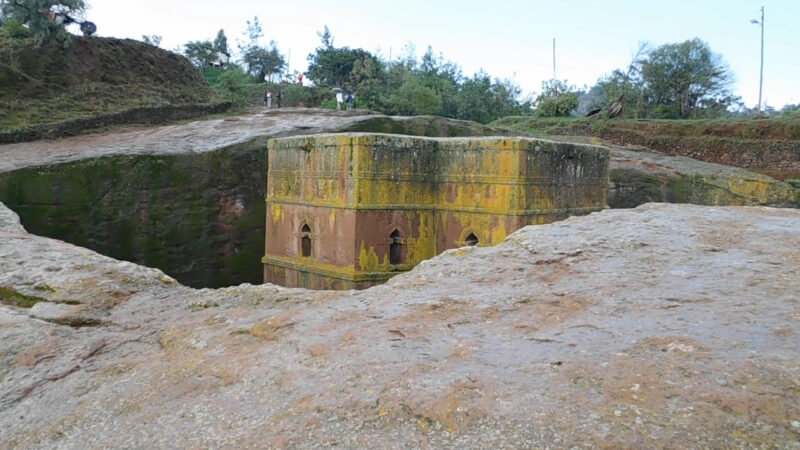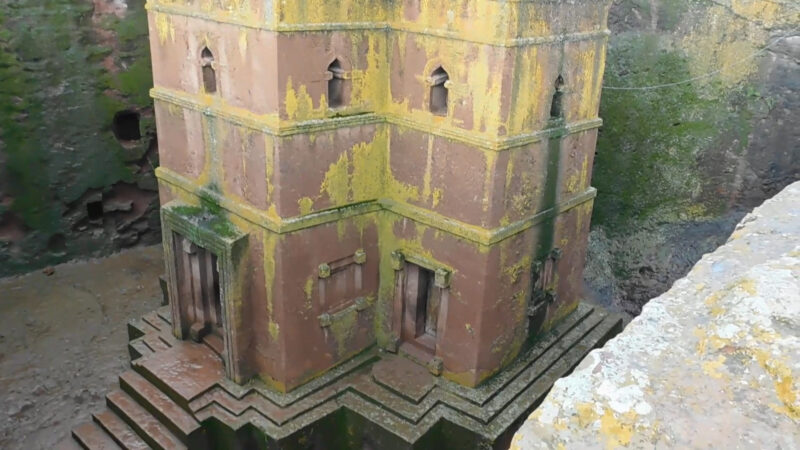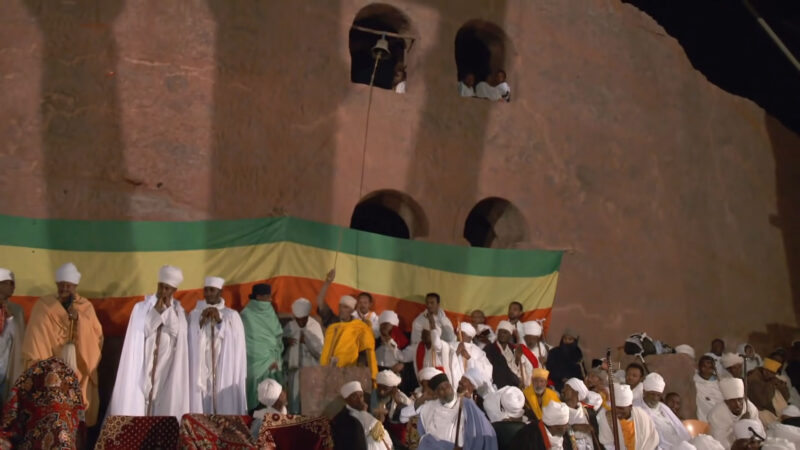Lalibela, Ethiopia is one of the most mesmerizing places you can visit in Africa. Known for its impressive rock-hewn churches, this village offers a blend of historical and religious significance.
When you explore Lalibela, you’ll find yourself stepping into a scene that feels timeless. From its ancient churches carved out of solid rock to its vibrant local culture, the town offers an experience like no other.
Understanding Lalibela’s unique characteristics will enhance your appreciation for this remarkable destination.
1) Church of Saint George

The Church of Saint George, also known as Bete Giyorgis, is the most well-known of the eleven rock-hewn churches in Lalibela, Ethiopia.
Built by King Gebre Mesqel Lalibela of the Zagwe dynasty, this church remains a significant cultural and religious site. According to legend, an angel appeared to the king, instructing him to construct the church.
The Church of Saint George is carved entirely out of rock. It stands out due to its cross-shaped structure and intricate design. This unique architecture makes it an architectural marvel, often called the “Eighth Wonder of the World.”
Lalibela, the town where the church is located, is named after its builder. This makes the Church of Saint George not just a religious site, but a historical one as well. The church is a symbol of Ethiopia’s rich history and deep-rooted tradition.
Visitors to the Church of Saint George can experience its serene environment. The church is part of a larger complex of rock-hewn churches, each with its own unique design and story.
2) Rock-Hewn Architecture
Lalibela is famous for its incredible rock-hewn churches. These churches were carved out of solid rock in the 12th and 13th centuries. You will find 11 of them, each unique in design and layout.
The largest rock-hewn church in Lalibela is Biete Medhane Alem. It is known for its impressive size and features a series of stone columns inside. All these structures were crafted using simple tools like chisels and hammers.
The churches are split into two main groups, divided by the Jordan River. One group represents earthly Jerusalem, while the other symbolizes heavenly Jerusalem. This reflects the deep religious beliefs of the time.
Each church is connected by a series of tunnels and narrow passageways.
The rock-hewn churches are not just places of worship. They are also architectural wonders. The craftsmanship and effort it took to create these structures are hard to imagine without modern technology.
If you visit, you will notice the attention to detail in every carving and structure. From crosses to intricate windows, every element has meaning and purpose.
The churches have stood the test of time, surviving natural disasters and human conflicts. They remain a symbol of faith, devotion, and architectural brilliance.
3) King Lalibela
View this post on Instagram
King Lalibela was an Ethiopian monarch who reigned during the late 12th and early 13th centuries. He is widely known for his ambitious project of constructing rock-hewn churches in the town now named after him. These churches are renowned for their intricate designs and are carved directly into the rock.
Lalibela’s life was quite unique. Early on, he lived as a recluse, but later he ascended to the throne of Ethiopia. After becoming king, he commissioned the construction of the famous churches, seeking to create a “New Jerusalem” for Ethiopian Christians.
Legends say that angels guided him in the construction of these churches. One popular story suggests that an angel took him to Jerusalem, inspiring him to build a replica in Ethiopia. This allowed local pilgrims to avoid the long and dangerous journey to Jerusalem.
King Lalibela is credited with the construction of ten rock-hewn churches during his lifetime. These structures are not only places of worship but also marvels of ancient architecture. They remain active religious sites today, attracting visitors and worshippers from around the world.
4) UNESCO World Heritage Site
Lalibela’s Rock-Hewn Churches were designated a UNESCO World Heritage site in 1978. These churches are important both spiritually and historically.
There are 11 monolithic churches in Lalibela, carved directly from rock. They date back to the 13th century and represent a ‘New Jerusalem’.
The churches attract visitors from all over the world. They are still active places of worship and pilgrimage for Ethiopian Christians.
To preserve these ancient structures, UNESCO has built protective coverings over four of the churches. These coverings help shield the churches from weather and wear.
5) Bet Maryam
Bet Maryam is one of the rock-hewn churches in Lalibela, Ethiopia. It stands out for its intricate design and decoration, which are more elaborate than some of the other churches.
This church is dedicated to the Virgin Mary, who holds a special place in Ethiopian Christianity. Pilgrims often flock to Bet Maryam due to its spiritual significance.
Bet Maryam has unique architectural features, including porches that extend from the main structure. This sets it apart from other churches in Lalibela.
The church is linked to legends, with some saying it was the first to be carved under King Lalibela’s direction. It remains a focal point for worship and pilgrimage.
Inside, Bet Maryam features a 10-meter high pillar that is accessed by a short tunnel from Bet Medhane Alem. The beautiful carvings and decorations inside make it a must-visit site for anyone exploring Lalibela.
6) The Tomb of Adam
View this post on Instagram
The Tomb of Adam in Lalibela, Ethiopia, is a notable landmark within the complex of rock-hewn churches. This site is a large, hollowed-out block of stone located near Bet Uraiel, another famous church in the area.
According to tradition, the tomb is said to represent the biblical Adam. The symbolic meaning behind this representation ties it to the broader religious significance of the region.
The Tomb of Adam is part of the larger narrative of Lalibela. The city, named after an Ethiopian king, is recognized for its extraordinary architecture and spiritual heritage.
When you visit, you’ll find the Tomb of Adam to be surrounded by an atmosphere of reverence. This stone structure, though simple, holds deep historical and cultural importance for visitors and locals alike.
7) Monolithic Design

The rock-hewn churches of Lalibela are remarkable for their monolithic design. Each church is carved from a single block of stone.
You can find eleven such churches in Lalibela. These churches are connected by a maze of narrow underground tunnels and passages.
These monolithic churches were built over 800 years ago. The precise craftsmanship and planning involved in their construction remain impressive. They are some of the largest monolithic sites in the world.
Walking around the bottom of these churches, you can see how they were carved directly into the earth.
8) 11 Medieval Churches

Lalibela is home to 11 medieval rock-hewn churches, each carved directly out of solid volcanic rock. These structures are not just architectural feats; they are also a testament to the craftsmanship of the time.
The churches were built during the reign of King Lalibela in the 12th century. Carved out of the rock rather than constructed with stone, the intricate interiors are designed with great care.
These 11 churches are part of a UNESCO World Heritage site. They are located in the Amhara region of Northern Ethiopia and are known for their impressive medieval monolithic design.
Each church has its own unique layout and design. Some are free-standing structures, while others are connected by a network of underground tunnels and narrow passages.
The churches are still active places of worship. Ethiopian Orthodox Christians visit these sacred sites for pilgrimage and devotion.
Many of these churches have a distinctive cross-shaped design. Bet Giyorgis (Church of St. George) is one of the most well-known, featuring a cross-shaped layout that attracts many visitors.
The rock churches of Lalibela are often compared to other famous rock-cut structures, like Petra in Jordan. Their unique construction method and historical significance make them one of Ethiopia’s top attractions.
9) Zagwe Dynasty
The Zagwe Dynasty ruled large parts of Ethiopia from around 1137 to 1270 AD. Known for their unique combination of a nomadic military lifestyle and devout Christianity, they left a significant mark on the region.
One of the most famous kings of this dynasty is Lalibela. He is renowned for constructing 11 monolithic churches in Lalibela, which are now UNESCO World Heritage sites.
The Zagwe kings were of Agaw descent, a Cushitic ethnic group native to northern Ethiopia and Eritrea. They emphasized religious and artistic achievements, which shaped Ethiopian culture during their reign.
The dynasty eventually ended when the last Zagwe king, Za-Ilmaknun, was defeated in battle. This marked the rise of the Solomonic dynasty, which would continue to shape Ethiopian history.
10) Pilgrimage Destination

Lalibela, Ethiopia, often called the “New Jerusalem,” is a key pilgrimage site for many believers. This spiritual place is known for its remarkable rock-hewn churches. Pilgrims come to experience the deep sense of faith and history embedded in these ancient structures.
Joining a morning mass is one way to immerse yourself in Lalibela’s religious atmosphere. These services often start at 5 AM. It’s an opportunity to witness local traditions and connect with the community.
During religious holidays, the town comes alive with white-robed pilgrims. Their chants and prayers echo through the narrow streets, creating a powerful ambiance. This shared spirituality is a cornerstone of Lalibela’s significance.
The churches are not just tourist attractions. They are active places of worship. Priests and monks maintain the religious practices that have been in place for centuries. You will see them conducting services and ceremonies daily.
Pilgrimage to Lalibela is more than just a visit; it’s an experience steeped in faith, history, and tradition. Every corner of the town reflects its religious heritage, making it a profound spiritual journey for those who visit.
In Conclusion
Lalibela offers a unique glimpse into history and spirituality. The town’s rock-hewn churches stand as an impressive feat of architecture and devotion from centuries past.
As a visitor, you get a chance to witness firsthand the intricate designs and underground tunnels that make up this UNESCO World Heritage site.
Lalibela remains an active place of worship, adding to its vibrant atmosphere. You can feel the blend of history and modern-day faith during your visit.
Be prepared to step into a different world, where the past meets the present in a harmonious setting. Your visit to Lalibela will not only be educational but also deeply moving.

